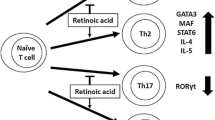Abstract
To elucidate the mechanism of vitamin A enhancing the production of antibody, we examined the expression and distribution of retinoic acid receptors mRNA in lymph nodes of young children ( ≤ 5 years of age), and investigated the affection of all-trans-retinoic acid on the maturation and activation of the B cells isolated from the lymph nodes and cultured in vitro. Twenty-four normal lymph nodes were collected. By in situ hybridization, we found that all six retinoic acid receptor genes expressed and distributed widely in the lymph nodes, and the levels of mRNA for retinoic acid receptor genes (detected by RT-fluorescent quantitative PCR) were increased with the development of children. In vitro culture, all-trans retinoic acid promoted the maturation and activation of the B cells from the lymph nodes. Thus, promotion on B cells in lymph node may be the important mechanism of vitamin A reinforcing the humoral immunity in young children.




Similar content being viewed by others
REFERENCES
Stephensen CB: Vitamin A: Infection, and immune function. Ann Rev Nutr 21:167–192, 2001
Levy Y, Labaume S, Gendron MC, Brouet JC: Modulation of spontaneous B-cell differentiation in macroglobulinemia by retinoic acid. Blood 83:2206–2210, 1994
Adelman DC, Yen TY, Cumberland WG, et al.: 13-cis retinoic acid enhances in vivo B-lymphocyte differentiation in patients with common variable immunodeficiency. J Allergy Clin Immunol 88:705–712, 1991
McCaffery P, Drager UC: Regulation of retinoic acid signaling in the embryonic nervous system: A master differentiation factor. Cytokine Growth Factor Rev 11:233–249, 2000
Rohwedel J, Guan K, Wobus AM: Induction of cellular differentiation by retinoic acid in vitro. Cells Tissues Organs 165:190–202, 1999
Berry C: Retinoic acid, neoplasia, differentiation and development. Virchows Arch 430:267–270, 1997
Gottgens B, Green AR: Retinoic acid and the differentiation of lymphohaemopoietic stem cells. Bioessays 17:187–189,1995
Degos L: All-trans-retinoic acid treatment and retinoic acid receptor alpha gene rearrangement in acute promyelocytic leukemia: A model for differentiation therapy. Int J Cell Cloning 10:63–69, 1992
Linney E: Retinoic acid receptors: Transcription factors modulating gene regulation, development, and differentiation. Curr Top Dev Biol 27:309–350, 1992
Tao Y, Yang Y, Wang W: Effect of all-trans-retinoic acid on the differentiation, maturation and functions of dendritic cells derived from cord blood monocytes. FEMS Immunol Med Microbiol 47:444–450, 2006.
Wang W, Ballow M: The effects of retinoic acid on in vitro immunoglobulin synthesis by cord blood and adult peripheral blood mononuclear cells. Cell Immunol 148:291–300, 1993
Yang H, Wang WP, Yang Y, Yao HL: Role of retinoic acid receptor in antibody synthesis of cord blood lymphocytes. Acta Nutr Sin 23:6–8, 2001
Morikawa K, Nonaka M: All-trans-retinoic acid accelerates the differentiation of human B lymphocytes maturing into plasma cells. Int Immunopharm 25(13–14):1830–1838, E pub 2005
Benn CS, Balde A, George E, Kidd M, Whittle H, Lisse IM, Aaby P: Effect of vitamin A supplementation on measles-specific antibody levels in Guinea-Bissau. Lancet 359:1313–1314, 2002
Wu BB, Wang WP, Yang Y: Role of Retinoic acid receptor antagonist on immunoglobulin M synthesis by cord blood lymphocytes. J Appl Clin Pediatr (Chin) 12:732–734, 2006
Ballow M, Wang W, Xiang S: Modulation of B-Cell immunoglobin synthesis by retinoic acid. Clin immunol Immunopathol 80(3 Pt 2):s73–s81, 1996
Rastinejad F: Retinoid X receptor and its partners in the nuclear receptor family. Curr Opin Struct Biol 11:33–38, 2001
Szabova L, Macejova D, Dvorcakova M, Mostbock S, Blazickova S, Zorad S, Walrand S, Cardinault N, Vasson MP, Rock E, Brtko J: Expression of nuclear retinoic acid receptor in peripheral blood mononuclear cells (PBMC) of healthy subjects. Life Sci 72:831–836, 2003
Wang WP, Yang Y, Su YX: Expression and regulation of retinoic acid receptors in human peripheral blood lymphocytes. Acta Nutr Sin 20:276–279, 1998
Monroe JG: B-cell positive selection and peripheral homeostasis. Immunol Rev 197:5–9, 2004
Carcetti R, Rosado MM, Wardmann H: Peripheral development of B cells in mouse and man. Immunol Rev 197:179–191, 2004
Cancro MP: Peripheral B-cell maturation: The intersection of selection and homeostasis. Immunol Rev 197:84–101, 2004
Allman DM, Ferguson SE, Cancro MP: Peripheral B cell maturation. J immunol 149:2533–2540, 1992
Loder F, Mutschler B, Ray RJ, Paige CJ, Sideras P, Torres R, Lamers MC, Carsetti R: B cell development in the Spleen takes place in discrete steps and is determined by the quality of B cell receptor-derived signals. J Exp Med 190:75–89, 1999
Chung JB, Silverman M, Monroe JG: Transitional B cells: Step by step towards immune competence. Trends Immunol 24:342–348, 2003
Zabala C, Lipsky PE: Immunomodulatory effects of bacterial lipopolysaccharide on human B lymphocyte activation in vitro. J Immunol 129:2496–2503, 1982
ACKNOWLEDGMENTS
This study is supported by the National Science Foundation of China, Grant 30371210 to Prof. Weiping Wang.
Author information
Authors and Affiliations
Corresponding author
Rights and permissions
About this article
Cite this article
Wei, D., Yang, Y. & Wang, W. The Expression of Retinoic Acid Receptors in Lymph Nodes of Young Children and the Effect of All-trans-Retinoic Acid on the B Cells from Lymph Nodes. J Clin Immunol 27, 88–94 (2007). https://doi.org/10.1007/s10875-006-9059-6
Received:
Accepted:
Published:
Issue Date:
DOI: https://doi.org/10.1007/s10875-006-9059-6




